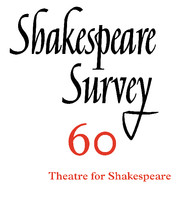Book contents
- Frontmatter
- Professional Players in the Guild Hall, Stratford-upon-Avon, 1568–1597
- Reconstructing The Rose: Development of the Playhouse Building between 1587 and 1592
- The Rose and its Stages
- Philip Henslowe and the Elizabethan Court
- From Revels to Revelation: Shakespeare and the Mask
- Bride-ing the Shrew: Costumes that Matter
- ‘When Men and Women are Alone’: Framing the Taming in India
- The Crown and the Pillow: Royal Properties in Henry IV
- Humanity at Stake: Man and Animal in Shakespeare’s Theatre
- Popular Shakespeare in Japan
- ‘Philosophy in a Gorilla Suit’: Do Shakespearians Perform or Just Perform-a-tive?
- Sudokothellophobia: Writing Hypertextually, Performatively
- Living Monuments: The Spatial Politics of Shakespeare’s Rome on the Contemporary Stage
- ‘In Windsor Forest and at the Boar’s Head’: The ‘Falstaff Plays’ and English Music in the Early Twentieth Century
- Michael Bogdanov in Conversation
- The Mouse and the Urn: Re-Visions of Shakespeare from Voltaire to Ducis
- ‘I covet your skull’: Death and Desire in Hamlet
- Martin Droeshout Redivivus: Reassessing the Folio Engraving of Shakespeare
- Canonizing Shakespeare: The Passionate Pilgrim, England’s Helicon and the Question of Authenticity
- Rereading Shakespeare: The Example of Richard Brathwait
- Shakespeare Performances in England, 2006: January 2006
- Professional Shakespeare Productions in the British Isles January–December 2005
- he Year's Contributions to Shakespearian Study 1 Critical Studies
- 2 Shakespeare in Performance
- 3 Editions and Textual Studies
- Index
Bride-ing the Shrew: Costumes that Matter
Published online by Cambridge University Press: 28 November 2007
- Frontmatter
- Professional Players in the Guild Hall, Stratford-upon-Avon, 1568–1597
- Reconstructing The Rose: Development of the Playhouse Building between 1587 and 1592
- The Rose and its Stages
- Philip Henslowe and the Elizabethan Court
- From Revels to Revelation: Shakespeare and the Mask
- Bride-ing the Shrew: Costumes that Matter
- ‘When Men and Women are Alone’: Framing the Taming in India
- The Crown and the Pillow: Royal Properties in Henry IV
- Humanity at Stake: Man and Animal in Shakespeare’s Theatre
- Popular Shakespeare in Japan
- ‘Philosophy in a Gorilla Suit’: Do Shakespearians Perform or Just Perform-a-tive?
- Sudokothellophobia: Writing Hypertextually, Performatively
- Living Monuments: The Spatial Politics of Shakespeare’s Rome on the Contemporary Stage
- ‘In Windsor Forest and at the Boar’s Head’: The ‘Falstaff Plays’ and English Music in the Early Twentieth Century
- Michael Bogdanov in Conversation
- The Mouse and the Urn: Re-Visions of Shakespeare from Voltaire to Ducis
- ‘I covet your skull’: Death and Desire in Hamlet
- Martin Droeshout Redivivus: Reassessing the Folio Engraving of Shakespeare
- Canonizing Shakespeare: The Passionate Pilgrim, England’s Helicon and the Question of Authenticity
- Rereading Shakespeare: The Example of Richard Brathwait
- Shakespeare Performances in England, 2006: January 2006
- Professional Shakespeare Productions in the British Isles January–December 2005
- he Year's Contributions to Shakespearian Study 1 Critical Studies
- 2 Shakespeare in Performance
- 3 Editions and Textual Studies
- Index
Summary
I recall a single, memorable moment of looking: Alexandra Gilbreath as Katherina in Gregory Doran’s 2003 Taming of the Shrew, kitted out for her wedding. Absorbed in her costume’s artifice – a paradise of ribbon rosettes, its skirt distended by a huge flat-topped farthingale – actor and character receded into the background: she was ‘all clothes’. In performance, this was a wedding dress that mattered. But when, much later, it surfaced in the archive on a mannequin, Kate’s costume bore little resemblance to my memory of what I had seen – a parody of the dress worn by Elizabeth I in the Ditchley portrait (illustration ). It is, of course, always surprising to see a costume’s theatrical life frozen on display, missing the intimacy of the body and, in this case, the farthingale. That I had mapped one gown over the other points not just to the tricksiness of looking and memory – one dress shadowing or haunting the other (ghosts on both sides) – but also to how fashion and theatre, avatars of one another, compose subjects as well as histories. ‘Speak, clothes, for me’, says the actor-as-character, says the play’s written language of costume. So what costume plot does Shakespeare write for Shrew, and especially for the actor who plays its title role? And how do Kate’s clothes – those worn by Gilbreath and by other Kate-actors – play with the most serious theme of human, and theatrical, consciousness – Who am I? – to perform the double dream of identity and play which lies at the heart of Shrew’s theatrical self-fashioning? The story that emerges from these questions involves double looking. First, setting Shrew’s written language of clothes alongside early modern social customs, I imagine how costume acts out and supports historical and cultural meanings; then, I explore how theatre’s fabrications have invited spectators to look at (and listen to) Kate’s speaking body in performance. This strand of my story, which returns to Gilbreath’s Kate, is and is not about that absent farthingale.
- Type
- Chapter
- Information
- Shakespeare Survey , pp. 72 - 83Publisher: Cambridge University PressPrint publication year: 2007

